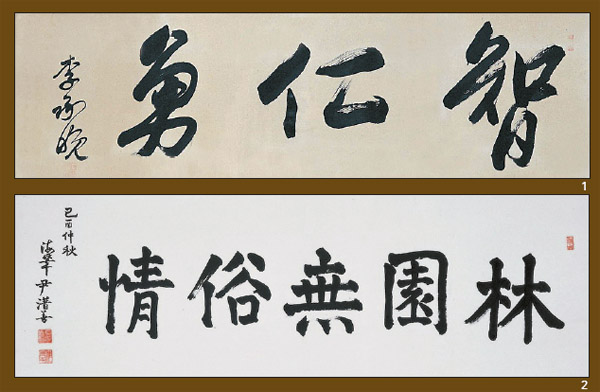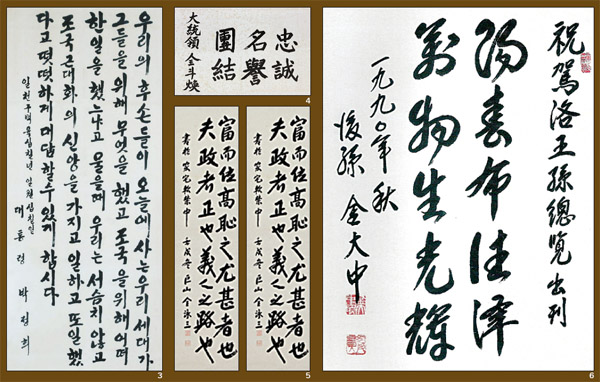Collectors open their wallets for presidents’ calligraphy

Calligraphy of former Korean presidents ranked by price earned at auction 1. Syngman Rhee / 155 million won / Seoul Auction, Dec. 2006 2. Yun Bo-seon / 2.2 million won / Seoul Auction, April 2006
Topping the list of successful art auctions are the works of Son Sang-ki and Chung Sang-hwa. No surprise there, as they’re both known for their talent. But the name that placed third wasn’t that of a professional artist, but rather an infamous politician: former President Park Chung Hee.
Pieces by Park were auctioned successfully in 91 percent of cases, according to data released by the Korea Art Appraisal Association. This number wasn’t far behind those for Son, who garnered 100 percent at a special auction, and Chung, with 92 percent.
So what makes a former president so popular in a field typically reserved for the most sophisticated of art collectors? Those with knowledge of the collecting world say that presidential writings don’t attract typical bidders who are looking for quality pieces. Instead, political junkies often come after presidential writings as they see the works as representative of the eras in which the leaders held power.
“The buyers tend to be supporters of the presidents, which is slightly different from collectors in the calligraphy market,” said Lee Sang-kyu, the head of K Auction.

3. Park Chung Hee / 110 million won / Seoul Auction, March 2007 4. Chun Doo-hwan / 11 million won / A Auction, Aug. 2010 5. Kim Young-sam / 6.5 million won / I Auction, June, 2010 6. Kim Dae-jung / 20 million won / A Auction, Dec. 2010 [JoongAng Ilbo]
President Kim Dae-jung, who was elected in 1998 in the wake of the Asian financial crisis, wrote “Gyeongsejemin,” which refers to using the state’s power to relieve people’s suffering.
One of Roh Moo-hyun’s writings, which discussed “the world in which people live,” was posted at a restaurant in Namyangju, Gyeonggi, and was sold for 5.1 million won ($4,457.65) in an online auction in 2004.
The writings can also reflect presidents’ individual ruling styles and philosophies, in addition to current events.
“Syngman Rhee’s writing is something that you could call textbook or orthodox, while Park Chung Hee’s writings embody the confidence and boldness of a top commander leading a nation,” said Lee Dong-guk of the Seoul Calligraphy Art Museum.
Based on totals of successful bid amounts, Park Chung Hee leads the presidential pack with 902.3 million won, followed by Syngman Rhee (515.5 million won), Kim Dae-jung (194.63 million won), Kim Young-sam (110.29 million won), Yun Bo-seon (17.5 million won) and Chun Doo Hwan (11 million won).
Park also beat out all the names in terms of the absolute number of calligraphy pieces that were auctioned. He is the only former Korean president whose calligraphy pieces are traded in addition to handwritten manuscripts and photos.
On average, one such piece costs 30 million won, according to collectors. That price is extremely high for any piece of calligraphy, as even the famous Oh Se-chang’s work trades for only between 2 and 3 million won.
One reason for Park’s unmatched popularity among collectors of presidential calligraphy is perhaps the rather significant role it played in his administration.
Among all of the Korean presidents, Park is most well known for using calligraphy in self-promotion projects and other governmental initiatives.
During his rule, Park left his calligraphy in different places all across the country, including at Gwanghwamun, the southern gate of the Gyeongbok Palace. That location is now a major tourist attraction.
And every New Year, the president would create a calligraphy piece in order to convey his vision for that year.
In 1962, for instance, a year after the military coup that brought him to power, Park wrote “Heokmyeongwansu,” or revolution completed.
In 1971 and 1972, when the Saemaeul Undong, or rural development movement, began, he wrote “progress without halt” and “let us overcome this emerging situation through autonomy and efficiency.”
In total, Park is thought to have left some 1,200 calligraphy pieces during his 18-year presidency. Collectors fond of his work dub Park’s writing style a “commander’s font” that is full of energy and spirit.
Park did indeed spend a significant amount of time with calligraphy over his lifetime. He first trained with Kim Yong-ha, a calligraphy master, and also the father of Daewoo founder Kim Woo-jung during his elementary school years. After he became president in a military coup, he continued learning with Son Jae-hyeong.
The attachment to traditional writing seems to have extended to his wife, Yuk Young-soo, as well. Collectors seem equally as eager to pick up writings from one of Korea’s beloved first ladies.
On June 20, a simple piece of hangul calligraphy authored by Yuk sold for 78 million won.
The price it fetched almost doubled the 40 million won paid at the same venue for calligraphy by Park Chung Hee.
As for competition from the sitting president, Lee of K Auction said that writings of a living president rarely enter that market. So, collectors’ taste for such works has yet to be tested.
But if history is any indication, there is likely to be a market for President Lee Myung-bak’s calligraphy in the future - if not for its beauty, then at least for its name value.
By Kwon Keun-young, Kim Hyung-eun [hkim@joongang.co.kr]










with the Korea JoongAng Daily
To write comments, please log in to one of the accounts.
Standards Board Policy (0/250자)